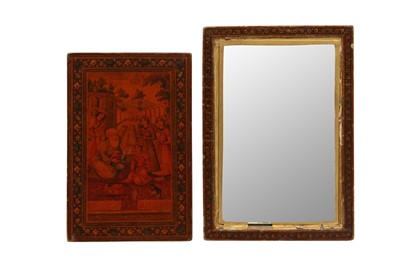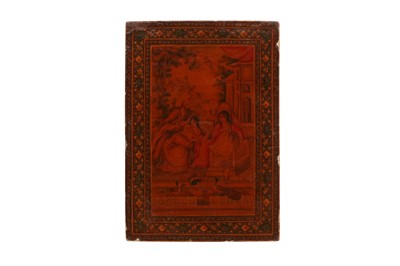28th Oct, 2022 11:00
Islamic Art - Property of a European Collector Part IV
A LACQUERED PAPIER-MÂCHÉ MIRROR CASE WITH NATIVITY SCENES
Najaf 'Ali Circle, Iran, late 18th - early 19th century
A LACQUERED PAPIER-MÂCHÉ MIRROR CASE WITH NATIVITY SCENES
Najaf 'Ali Circle, Iran, late 18th - early 19th century
Of typical rectangular shape, the mirror case painted in polychromes, heightened in gold, and lacquered, the front and back covers decorated with two Nativity scenes inspired by Christian engravings imported from the West, featuring a Qajar maiden holding a baby boy, surrounded by three men, and several winged angels and cherubs in the sky looking down at the holy child, the background featuring a number of Westernised architectures and bucolic landscapes with an elderly shepherd, the front inscribed 'Ya Sadiq al-Wa'd' (the takhallos of the Zand artist Muhammad Sadiq, active 1740–90s) and dated 1135 AH (1722) in red, each panel framed within concentric decorative borders with stylised vegetal sprays in polychromes and gold against black and brown grounds, the inner panel of the front cover decorated with a group of three pupils listening to their master and framed within decorative floral borders similar to the outer panel, 25.2cm x 17.8cm.
The chromatic choice of depicting the Qajar maiden with a red robe under a blue cloak is not accidental. In Christian iconography, this combination is typically associated with the Virgin Mary and her cult, as portrayed in the Renaissance masterpiece of the Madonna del Prato by Raphael and several other renowned European Old Masters paintings. This association implies that the three men, two much older and a third younger, surrounding the Virgin are either the Three Wise Men or the eldest two together with Joseph.
In the 1700s and 1800s, biblical imagery was imported into Iran through a variety of media and objects. In the Qajar era, Christian religious subjects, such as the Holy Family or Mary's Annunciation, enjoyed great success: Persian artists replicated models in varying ways, often depriving them of their specific religious meaning and combining different iconographic elements at once. It is, however, rare to see completely unexpected and new iconographic solutions: most artists repeated the same canonised model over and over, allowing themselves occasionally to recombine certain elements, but never overwriting or erasing them (D. Roxburgh, 'The Harvard Qajar Album - From Cover to Cover' in An Album of Artists's Drawings from Qajar Iran, 2017, p. 26).
The inscription 'Ya Sadiq al-Wa'd' usually refers to Muhammad Sadiq, an 18th-century painter of lacquer, oil paintings, and watercolours who was particularly skilled in depicting figures, flowers, battles, and hunting scenes. Although the style and the choice of depicting Christian subjects are in line with this master's production (see Christie's London, 11 April 2014, lot 151), the date 1135 AH (1722) clashes with his usual timeline, since he is reputed to have been active between the 1740s and 1790s. To know more about this artist and his recorded works, please see M. A. Karimzadeh Tabrizi, The Lives & Art of Old Painters of Iran, vol. 1, London, 1985, pp. 257-64.
On the other hand, the stylistic composition and the characters' placement on the back cover of this lot present several similarities with a renowned Christian iconographic model attributed to the Qajar painter and lacquer master Najaf 'Ali ('Ya Shah-e Najaf'), mostly active in Isfahan between the 1830s - 1850s. To view the original sketch of the back cover scene, please see M. A. Karimzadeh Tabrizi, Qalamdan and Persian Lacquer Work, 2000, p. 351. Another Holy Family sketch attributed to the Najaf Circle, dated 1780 - 1850, and presenting an almost identical composition to our front cover, including the characters of the Magi and female companions in the background, is preserved in the Harvard Qajar Album and published in D. Roxburgh (ed.), An Album of Artists's Drawings from Qajar Iran, 2017, folio 6a (acc. no. 1960.161.6), further corroborating the link with Master Najaf's works. Lastly, another analogous scene with the Three Wise Men is featured on the front case of a lacquered mirror case in the Khalili Collection of Islamic Art (acc. no. LAQ44). This object has also been attributed to Najaf 'Ali.
It is, therefore, plausible that the inscription 'Ya Sadiq al-Wa'd' and the date 1135 AH have been added at a later stage, and that this mirror case should instead be attributed to the Isfahani Najaf Circle of artists working in the lacquer painter's guild, of which Najaf 'Ali was the head. One could wonder if this inscription, a clear reference to the artist Muhammad Sadiq, could bear an honorary and tributary significance, rather than acting as a clear attribution, since Najaf 'Ali is believed to have been trained by Sadiq (Nasser D. Khalili, B.W. Robinson, and Tim Stanley, Lacquer of the Islamic Lands: Part Two, 1997, p. 27).
Sold for £2,000
Includes Buyer's Premium
Do you have an item similar to the item above? If so please click the link below to submit a free online valuation request through our website.



